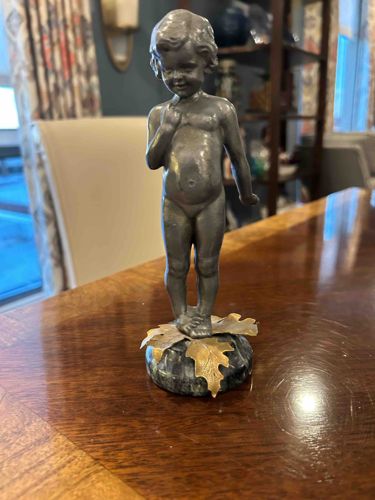
Art Nouveau Figural Child Statue (Possibly Pewter or Spelter on Marble Base)
This is a figural statue depicting a young, nude child, likely a boy due to the slightly more robust facial features often associated with depictions of male children in early 20th-century sculpture, though it could also be interpreted as an androgynous cherubic figure. The child figure itself appears to be cast metal, possibly pewter or spelter, given its matte, silvery-gray finish and the visible subtle texture of the metal. The pose is naturalistic and endearing, with the child shifting weight slightly, one arm bent at the elbow with the hand gently resting near the chest, and the other arm slightly outstretched. The facial expression is sweet and innocent, with a gentle smile and delicate curls framing the face. The craftsmanship on the figure suggests attention to detail in modeling the anatomy and expression. The child stands barefoot upon a decorative base. The base consists of two main parts: a dark, possibly marble or alabaster, rounded plinth with a mottled gray and black appearance, suggesting a natural stone material. Surrounding and partially covering this plinth are several detailed metallic leaves, which appear to be brass or bronze due to their golden hue and slight sheen, providing a striking contrast to the darker base and the child figure. These leaves are artfully arranged, some slightly overlapping, enhancing the naturalistic theme. The overall condition appears good for its age, with a visible patina on the metal child figure and a rich, aged luster on the golden leaves. No significant chips, cracks, or repairs are immediately apparent from the provided images, though closer inspection would be required to confirm. The style, particularly the naturalistic depiction of the child and the use of botanical elements in the base, points towards the Art Nouveau period, likely late 19th to early 20th century. The combination of different metals and stone for the base further accentuates its decorative appeal.
AI-Generated Appraisal Disclaimer
Estimated Value
$350-550
Basic Information
Category
Sculpture/Figurine
Appraised On
December 23, 2025
Estimated Value
$350-550
Item Description
This is a figural statue depicting a young, nude child, likely a boy due to the slightly more robust facial features often associated with depictions of male children in early 20th-century sculpture, though it could also be interpreted as an androgynous cherubic figure. The child figure itself appears to be cast metal, possibly pewter or spelter, given its matte, silvery-gray finish and the visible subtle texture of the metal. The pose is naturalistic and endearing, with the child shifting weight slightly, one arm bent at the elbow with the hand gently resting near the chest, and the other arm slightly outstretched. The facial expression is sweet and innocent, with a gentle smile and delicate curls framing the face. The craftsmanship on the figure suggests attention to detail in modeling the anatomy and expression. The child stands barefoot upon a decorative base. The base consists of two main parts: a dark, possibly marble or alabaster, rounded plinth with a mottled gray and black appearance, suggesting a natural stone material. Surrounding and partially covering this plinth are several detailed metallic leaves, which appear to be brass or bronze due to their golden hue and slight sheen, providing a striking contrast to the darker base and the child figure. These leaves are artfully arranged, some slightly overlapping, enhancing the naturalistic theme. The overall condition appears good for its age, with a visible patina on the metal child figure and a rich, aged luster on the golden leaves. No significant chips, cracks, or repairs are immediately apparent from the provided images, though closer inspection would be required to confirm. The style, particularly the naturalistic depiction of the child and the use of botanical elements in the base, points towards the Art Nouveau period, likely late 19th to early 20th century. The combination of different metals and stone for the base further accentuates its decorative appeal.
Related Tags
Get Your Items Appraised
Instant estimates of your treasures with AI-powered instant appraisals